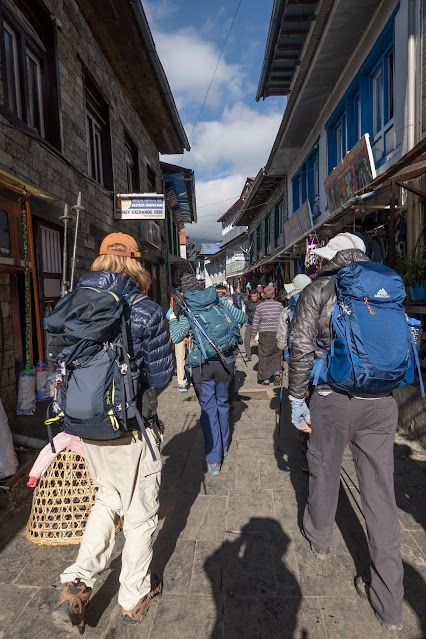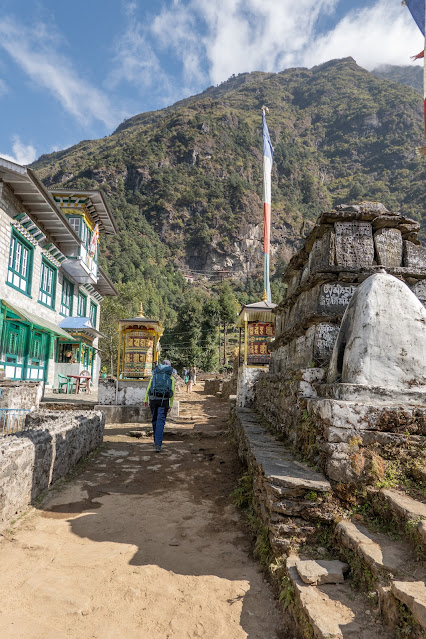If you are just joining the blog, here are the earlier posts that will set the scene:
Kathmandu
Trek Part I: Lukla to Namche
Trek Part II: Namche to Khunde
Also, I'm aware that it's New Year's Eve. Have a great time, and a better 2022.
Trekking Day 5:
We left Khunde and walked down through the neighboring town of Khumjung, stopping at the monastery where a multi-day ceremony was taking place to honor a dead elder of the community.
 |
| Walking towards Khumjang |
 |
| The Khumjang gompa |
 |
| Kim Bannister of Kamzang Journeys giving the large prayer wheel a spin. |
There seemed to be no issues with us taking photos, nor with some coming and going. When I saw that our Bhuddist guide, Lhakpa, was taking pictures, I tried to capture some of the feel of the place. Part of the significance of this gompa is that they have what they claim is the only yeti scalp in existence. I'll skip the close-up.
 |
| Yeti scalp in the display case. |
Continuing on, we stayed on the high trail above the Dudh Koshi river to climb to Mong La and on to Phortse.
 |
| A glimpse of the very well-built trail. Zooming in showed us that we had a lot of steps to climb. Ama Dablam (22,349'/6812 meters) is prominent in the distance. |
Climbing toward Mong La ("la" means pass, but in this case it was more the high point passing over a shoulder of the mountain), with our day's destination visible in the distance.
 |
| At this point in the trip, the weather was still warm, as we were at "only" about 12,500'. That didn't feel low until much later in the trip! |
We had great views of Phortse, which wasn't far off. Only... yeah, we had to drop several hundred feet to cross the Dudh Koshi river, coming in from the left from Gokyo. We will follow the Imje Khola up the valley to the right, towards Ama Dablam.
Cool trivia bit: volleyball is big in the Khumbu, and while we were in Phortse, the Khumbu tournament was going on a short way below our lodge. We heard later that Phortse took the championship.
 |
| Arriving in Phortse. The villages have suddenly gotten much smaller. |
Day 6: Phortse to Pangboche
 | |
| Hiking out of Phortse in the morning. The view is up the Dudh Koshi (towards Gokyo). |
 |
| The route had its ups and downs, but was never short of scenery. |
Thanks to recent efforts to contain and remove trash, the trails were remarkably clean. But those blasted plastic bags get everywhere. My son had enough extra energy (thanks to being the only member of the party under 50, I think) to do a little rescue work. Skip the plastic, folks!
 |
| Ama Dablam, Lhotse, and our destination (Pangboche) in the valley below |
Descending through Upper Pangboche, past the monastery, with Ama Dablam looming over everything.
 |
| Shining copper prayer wheels at the Pangboche monastery. |
Always happy to arrive at our lodge! Some members of the party went back out to tour the town; I enjoyed a hottish shower in an almost-warm room.
 |
| The view from the dining room |
We were to spend 2 nights here, with a visit to Ama Dablam base camp on the layover day, so it was laundry time! Washing clothes in icy water by hand was made slightly easier by the rubber kitchen gloves I had thought to take. It still took ages to thaw my fingers afterwards.
 |
| Our laundry line. Most of that was frozen before it was dry. |












































